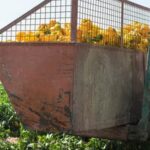Vegetable gardens are a popular and rewarding way to grow your own fresh produce, but ensuring that your plants receive the right amount of water can be a challenge. This is where irrigation systems for vegetable gardens come in. These systems are designed to efficiently and effectively deliver water to your plants, promoting healthy growth and higher yields.
In this article, we will explore the various options available for irrigation systems for vegetable gardens, including drip irrigation, soaker hoses, and DIY solutions. We will discuss the benefits of using these systems and how they can help you maintain a healthy and thriving garden throughout the growing season.
Whether you are new to gardening or an experienced enthusiast, having a reliable irrigation system in place can make a significant difference in the success of your vegetable garden. By understanding the different types of irrigation systems available and how they work, you can make an informed decision about which option is best suited for your specific garden needs.
The Best Irrigation System Options for Vegetable Gardens
When it comes to choosing the best irrigation system for your vegetable garden, there are several options to consider. One of the most popular choices is drip irrigation, which involves delivering water directly to the base of each plant through a system of tubes and emitters.
This method is highly efficient, as it reduces water loss due to evaporation and prevents foliage from getting wet, which can lead to disease. Drip irrigation also allows for precise control over the amount of water delivered to each plant, ensuring that they receive just the right amount.
Another option to consider is soaker hoses, which are porous hoses that deliver water directly to the soil. They can be laid on the surface or buried under a few inches of soil, providing slow and steady watering to the root zone. Soaker hoses are easy to install and work well for gardens with rows of plants, such as carrots or lettuce.
For those who prefer a more traditional approach, overhead sprinklers can also be used in vegetable gardens. While not as water-efficient as drip irrigation or soaker hoses, overhead sprinklers can cover a large area and are ideal for gardens with a variety of vegetables that have different watering needs.
Ultimately, choosing the best irrigation system for your vegetable garden will depend on factors such as the size of your garden, the types of vegetables you are growing, and your own preferences. No matter which system you choose, proper installation and maintenance are key in ensuring that your vegetable garden receives adequate water without wasting this precious resource.
| Irrigation System Option | Benefits |
|---|---|
| Drip Irrigation | Precise control over water delivery; reduces water loss and prevents disease |
| Soaker Hoses | Slow and steady watering; ideal for gardens with rows of plants |
| Overhead Sprinklers | Covers large area; suitable for gardens with varied watering needs |
Drip Irrigation
The benefits of using drip irrigation for vegetable gardens are numerous. For one, this method conserves water by minimizing evaporation and runoff. Additionally, it allows for better control over the amount of water each plant receives, ensuring that they get just the right amount without being overwatered. Drip irrigation also helps prevent weed growth by focusing the water on the plants themselves rather than on empty spaces between rows.
Some options for drip irrigation systems include:
- Emitters: These are devices that control how much water is released and at what rate.
- Tubing: Flexible tubing connects to your main water source and guides water to specific areas.
- Timers: These devices can be programmed to turn your drip system on and off at specific times.
Overall, drip irrigation offers a precise way to deliver the necessary moisture to vegetable gardens without wasting resources.
When choosing an irrigation system for your specific vegetable garden, it’s important to consider factors such as the size of your garden, the types of vegetables you are growing, and your local climate. Different plants have different watering needs, so it’s essential to select an irrigation system that can be tailored to meet those needs accurately. With proper research and planning, you can ensure that your vegetable garden thrives with the right irrigation system in place.
Choosing the Right Watering Method for Your Specific Vegetable Garden
When it comes to watering your vegetable garden, choosing the right method is crucial for the health and productivity of your plants. There are several factors to consider when deciding on the best watering method for your specific vegetable garden, including the type of vegetables you are growing, the size of your garden, and the local climate. Here are some popular options to consider:
- Drip irrigation: This method involves using hoses or tubing with small holes to slowly drip water directly onto the soil at the base of each plant. Drip irrigation is a great option for vegetable gardens because it delivers water directly to the roots, minimizing evaporation and reducing the risk of fungal diseases.
- Sprinkler systems: Sprinklers are a convenient way to cover a large area with water, making them a good choice for larger vegetable gardens. However, they may not be as efficient as other methods and can lead to wasted water due to evaporation and runoff.
- Soaker hoses: Similar to drip irrigation, soaker hoses release water directly into the soil, but they do so along the entire length of the hose. This can be a good option for longer rows of vegetables or raised beds.
It’s important to consider your specific garden layout and watering needs when choosing an irrigation system. For example, if you have a small vegetable plot with diverse watering needs among different plants, a combination of drip irrigation and soaker hoses might be the best solution. On the other hand, if you are growing primarily leafy greens like lettuce and spinach in raised beds, a simple hand-watering or drip system could work well.
In addition to considering your garden layout and plant needs, it’s important to factor in local climate conditions when choosing an irrigation system. For example, in hot and dry climates, you may need a more efficient system like drip irrigation to ensure that your vegetables receive enough water without excessive evaporation. Understanding these factors will help you choose the best watering method for your specific vegetable garden’s needs.
DIY Irrigation Systems for Vegetable Gardens
Maintaining a healthy vegetable garden requires consistent and adequate watering, which is where irrigation systems come into play. For those who enjoy taking a hands-on approach to gardening, creating a DIY irrigation system for their vegetable garden can be a rewarding and cost-effective option. There are several effective techniques that do-it-yourselfers can utilize to ensure their vegetable garden receives the right amount of water without having to manually water each plant.
One popular DIY irrigation system for vegetable gardens is the soaker hose method. Soaker hoses are porous and allow water to seep out slowly, delivering moisture directly to the base of the plants.
They are easy to install and can be customized to fit the specific layout of your garden. Another option for DIY irrigation systems is using simple drip irrigation tubing with emitters placed near each plant, ensuring that water goes straight to the roots where it is needed most.
When considering a DIY irrigation system for your vegetable garden, it’s important to take into account factors such as the size of your garden, the types of vegetables you are growing, and the local climate conditions. Additionally, regular maintenance of your DIY irrigation system is essential for ensuring its effectiveness in keeping your vegetable garden healthy and thriving.
| DIY Irrigation Systems | Benefits |
|---|---|
| Soaker Hose | Easy installation and customization |
| Drip Irrigation Tubing | Precise watering directly to plant roots |
The Pros and Cons of Different Irrigation Systems for Vegetable Gardens
When it comes to irrigating your vegetable garden, there are several different irrigation systems to choose from. Each system has its own pros and cons, so it’s important to weigh these factors before deciding which one is best for your specific garden.
Drip Irrigation
One of the most popular irrigation systems for vegetable gardens is drip irrigation. This system works by delivering water directly to the base of the plants, minimizing water waste through evaporation or runoff.
Drip irrigation also allows for precise control over the amount of water delivered to each plant, ensuring that they receive just the right amount of moisture. However, one drawback of drip irrigation is that it can be more expensive to install than other systems, and may require more maintenance over time.
Sprinkler Systems
Another commonly used irrigation system for vegetable gardens is a sprinkler system. This type of system distributes water over a large area, making it ideal for larger gardens. Sprinkler systems are also relatively easy to install and can be automated for convenience. However, they can be less efficient than drip irrigation, as some water may be lost to evaporation or runoff.
Soaker Hoses
Soaker hoses are another option for irrigating vegetable gardens. These hoses deliver water directly to the soil along their length, allowing for slow and consistent moisture distribution. Soaker hoses are easy to install and can be used in smaller or oddly shaped garden plots. However, they may not provide as precise control over watering as drip irrigation and can be prone to clogging if not properly maintained.
Overall, each type of irrigation system has its own benefits and drawbacks when it comes to vegetable gardening. It’s important to consider factors such as cost, efficiency, ease of installation and maintenance before choosing the best option for your specific garden needs.
Maintaining Your Irrigation System
Regular Inspection and Maintenance
Once you have installed your irrigation system for your vegetable garden, it is important to regularly inspect and maintain it to ensure that it is working efficiently. Check for any clogs in the drip lines, leaks in the hoses, or any other malfunctions that may hinder the proper watering of your garden. It is also important to clean the filters and emitters regularly to prevent blockages and ensure a consistent flow of water to your plants.
Adjusting for Seasonal Changes
Different seasons bring different weather patterns, which can affect the water needs of your vegetable garden. During hotter months, you may need to increase the frequency and duration of watering to prevent your plants from drying out. Conversely, during cooler months or periods of rain, you may need to adjust your irrigation system to avoid overwatering. Being mindful of these seasonal changes and adjusting your irrigation system accordingly will help keep your vegetable garden healthy and thriving.
Utilizing Smart Technology
With advancements in technology, there are now smart irrigation controllers available that can automatically adjust the watering schedule based on weather forecasts, soil moisture levels, and specific plant needs. These systems can be a valuable tool for maintaining an optimal watering schedule for your vegetable garden while conserving water. Consider integrating smart technology into your irrigation system for more efficient and effective watering practices.
By following these tips for maintaining your irrigation system, you can ensure that your vegetable garden remains adequately watered and healthy throughout the growing season. Proper maintenance and adjustments as needed will not only benefit the overall health of your plants but also contribute to conserving water resources in the process.
Conclusion
In conclusion, the use of irrigation systems for vegetable gardens offers numerous benefits that can greatly improve the health and productivity of your crops. From ensuring consistent and efficient watering to saving time and water, irrigation systems are an essential tool for any vegetable garden enthusiast.
One of the key advantages of utilizing irrigation systems for vegetable gardens is the ability to deliver water directly to the roots of plants, which promotes healthy growth and reduces the risk of disease. Drip irrigation, in particular, stands out as an excellent option for vegetable gardens due to its precision and water conservation capabilities.
By providing a slow, steady flow of water at ground level, drip irrigation minimizes water waste and helps maintain optimal soil moisture levels for your vegetables.
Frequently Asked Questions
What Type of Irrigation Is Best for Vegetable Garden?
The best type of irrigation for a vegetable garden is drip irrigation. This method delivers water directly to the roots of the plants, reducing water waste and minimizing weed growth. Drip irrigation also helps prevent disease by keeping the foliage dry.
What Is the Most Efficient Method of Irrigation for Vegetable Crops?
The most efficient method of irrigation for vegetable crops is also drip irrigation. It delivers water precisely where it’s needed, conserving water and reducing the likelihood of overwatering or underwatering. This method also minimizes evaporation compared to overhead sprinklers.
What Is the Best Irrigation for Garden Beds?
The best irrigation for garden beds is drip irrigation as well. This method allows you to water the soil without wetting the leaves, which can help prevent fungal diseases. It also provides a consistent moisture level, encouraging healthy root growth and overall plant development in garden beds.

If you’re looking to get into vegetable gardening, or are just looking for some tips on how to make your current garden better, then you’ve come to the right place! My name is Ethel and I have been gardening for years. In this blog, I’m going to share with you some of my best tips on how to create a successful vegetable garden.





